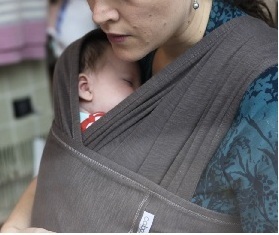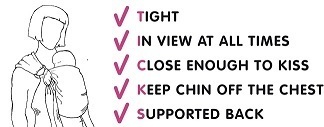Using a Sling for Daytime Sleep
Using a Sling for Daytime Sleep
Around the world, babies are carried by their mothers (and fathers, siblings and community members) throughout the day. These babies spend their days sleeping in a sling, which is usually made from a simple piece of cloth. In the UK and US, the practice of carrying a baby in a sling or soft baby carrier is known as ‘baby wearing’. It’s less common for parents in the UK to use a sling for their babies’ daytime sleep but there are many reasons why this may be helpful.
What are the benefits?
Carrying your baby in a sling while they sleep may benefit them, while also allowing you to have your hands free. Little research has looked specifically at the benefits of carrying babies in a sling while they sleep. However research in related areas suggests that keeping close contact may have benefits for both mother and baby.
The advice for new parents is that your baby should sleep in the same room as you, day and night, until they are at least 6 months old. Studies have shown this to reduce the risk of SIDS. An English study, comparing 325 SIDS babies with 1300 control babies, found that 75% of the day-time SIDS deaths occurred while babies were alone in a room. (Sudden Infant Death Syndrome and the time of death: factors associated with night-time and day-time deaths. Blair et al., 2006) Using a sling or baby carrier may make it easier for you to keep your baby close during the day.
Research (e.g. Should Neonates Sleep Alone. Morgan et al., 2011; Does infant carrying promote attachment? An experimental study of the effects of increased physical contact on the development of attachment. Anisfeld et al., 1990) looking at newborn babies has shown that close contact helps them to sleep more quietly and for longer. They can hear your heartbeat, feel your movements and be reassured that you are close, and will not feel the stress of being separated from you. When your baby starts to stir, you will be immediately aware of it if you are wearing them. You can pick up on their feeding cues more easily (Correlates of lactation in mothers of very low birthweight infants. Furman et al., 2002) and breast milk production is improved (Kangaroo care and breastfeeding of mother-preterm infant dyads 0-18 months: a randomized, controlled trial. Hake-Brooks & Anderson, 2008) when you keep your baby close to you. Some research shows that mothers who hold their babies feel calmer, and less anxious, and show less cortisol reaction to stress.
Effects of suckling on hypothalamic-pituitary-adrenal axis responses to psychosocial stress in postpartum lactating women. Heinrichs et al., 2001.
Parents who formula feed may find that wearing their baby helps them to bond and, for Dads and partners, baby wearing may allow you to take your baby for a walk, giving your partner some time to themselves.
You can find more information on how babies sleep here

Are there any disadvantages?
Sometimes parents are worried that babies who settle to sleep in a sling or baby carrier may be less likely to settle on their own.
Parental experience highlights that there is huge variability in babies’ sleep preferences. While some babies settle better when they sleep in a cot alone, others find it difficult to settle if put down for sleep alone. Studies show that babies need to have positive sleep associations and that babies whose sleep environment is calm, and for whom going to sleep is pleasant, will develop better long-term sleeping habits. For some babies a calm and pleasant sleep environment involves being in contact with their mother or other caregiver – a typical practice in many countries. Some babies therefore prefer to settle by being soothed by their parents, and not by being left alone, so these babies fall asleep happily in a sling. Some slings are easy to take off if your baby falls asleep at night time and you want to take the sling off without disturbing them. Sometimes parents choose to wear their babies until they fall asleep and then lie them down.
Is baby wearing safe?
Babies born prematurely who are carried (in skin-to-skin contact) by their parents have improved temperature regulation, increased oxygen saturation and, over time, better growth. The World Health Organisation (Kangaroo Mother Care: A Practical Guide. World Health Organisation, 2003. Available from whqlibdoc.who.int/publications/2003/9241590351.pdf) supports 24 hour a day baby wearing for premature babies, until they reach their full gestational age, especially where modern medical care is unavailable to parents. While most parents won’t need to consider wearing their babies in direct skin contact, or 24/7, this should offer some reassurance that wearing a baby can be safe and beneficial, even during a long daytime nap.

Following some simple guidelines will help you to keep your baby safe in a sling.

As with any item of baby equipment, you may want to take some time to practise using a sling or baby carrier, perhaps with another adult watching you. Be sure to follow the manufacturers’ instructions for safe use of any sling, carrier or other equipment. Carefully check any sling or baby carrier that you own, buy or borrow for wear and tear. Only undertake safe activities while your child is in the sling or baby carrier – no jogging, cycling or extreme sports!
Be careful in selecting your sling, carrier or other equipment. Some ‘bag style’ slings are shaped in a way that leads to the baby curling up in the sling, pressing their chin towards the chest.
Further safety information and details of TICKS are available on the School of Babywearing Website and at Which? (Consumers’ Association).
For information about the different types of sling available, visit www.babywearing.co.uk, or find a sling meet, group or library or a Babywearing Consultant near you on their information pages.
For more detailed information about the use of slings for daytime sleep, click here.
